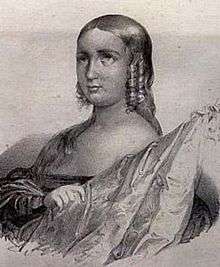Mariana de Pineda Muñoz

Mariana de Pineda y Muñoz, generally known as Mariana Pineda, (Granada, 1 September 1804– Granada, 26 May 1831) was a Spanish liberalist heroine.[1]
At a very young age, Mariana married Manuel Peralta Valte, a liberal army officer, but was widowed in 1822 with two children. After her husband's death, Mariana became very involved in liberal causes. In 1828 she assisted in Captain Fernando Álvarez de Sotomayor's escape from prison. He was a noted liberal who had been condemned to death for taking part in General Rafael Riego's insurrection, and also Mariana's cousin.
In a search of her house in 1831, a flag was discovered with the embroidered slogan 'Equality, Freedom and Law' and Mariana was arrested and accused of conspiracy. After a failed escape attempt, she was detained in the Santa María Egipciaca convent in Granada. During the trial, the Judge tried to persuade her to betray her accomplices in exchange for leniency, but she refused. Mariana was publicly executed by the garrote on May 26.
In 1925 the playwright Federico García Lorca based his play Mariana Pineda on her story, propelling the popular heroine into legend and myth. Between 1965 and 1969 the French composer Louis Saguer (1907–1991) composed an opera on the subject. The work premiered in 1970 in Marseille and was awarded the Grand Opera Prize of Monaco (1970).
Another Spanish playwright, José Martín Recuerda, a native of Granada, wrote "Las arrecogías del Beaterio de Santa María Egipciaca" based on the imprisonment of Mariana Pineda. The play was adapted and translated into English by Robert Lima as "The Inmates of the Convent of St. Mary Egyptian" and premiered on March 17, 1980 with a professional cast at The Pennsylvania State University. Upon its publication in DramaContemporary: Spain (1985), edited by Marion Peter Holt, the play was performed at the Edinburgh Festival Fringe by the Oxford Theatre Group in 1988.
A hall inside the Seat of the European Parliament in Strasbourg bears her name.[2]
References
- ↑ Article from Ideal, Andalusian newspaper
- ↑ Photo showing Ban Ki-moon and Jerzy Buzek walking through the Espace Mariana de Pineda on 19 October 2010